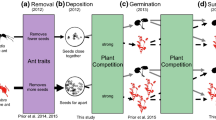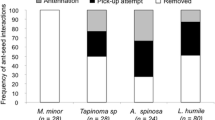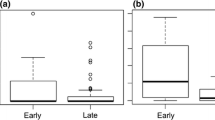Abstract
An important feature of seed dispersal mutualism is the differentiation of dispersal-related seed traits (dispersal syndrome), which potentially contribute to partitioning of both seed dispersers and regeneration sites among sympatric plants. Yet, the selective factors underlying the diversity in dispersal syndromes are largely unknown. The differential requirements for seed dispersal distances are often proposed as a main factor in plant adaptations to disperser animals. Focusing on two sympatric ant-dispersed sedges Carex lanceolata and Carex tristachya (Cyperaceae), we tested the association of the adaptation to different dispersers with requirements for seed dispersal distances. We found that C. lanceolata was more frequently dispersed by the large ant Formica japonica (which had relatively long dispersal distances compared with other smaller ants) than by C. tristachya, and this was caused by the higher seed attractiveness of C. lanceolata to F. japonica. Pot experiments manipulating adult-to-seedling distances showed that isolation from conspecific adults only benefited C. lanceolata seedlings, and C. tristachya seedlings were not affected. These results support the importance of differential requirements for seed dispersal distances as a factor underlying the diversity in dispersal syndromes among animal-dispersed plants.


Similar content being viewed by others
References
Alcántara JM, Rey PJ, Manzaneda AJ et al (2007) Geographic variation in the adaptive landscape for seed size at dispersal in the myrmecochorous Helleborus foetidus. Evol Ecol 21:411–430
Amico GC, Rodriguez-Cabal MA, Aizen MA (2011) Geographic variation in fruit colour is associated with contrasting seed disperser assemblages in a south-Andean mistletoe. Ecography 34:318–326
Augspurger CK (1984) Seedling survival of tropical tree species: interactions of dispersal distance, light-gaps, and pathogens. Ecology 65:1705–1712
Baldwin JW, Whitehead SR (2015) Fruit secondary compounds mediate the retention time of seeds in the guts of neotropical fruit bats. Oecologia 177:453–466
Beck MJ, Vander Wall SB (2010) Seed dispersal by scatter-hoarding rodents in arid environments. J Ecol 98:1300–1309
Bode M, Bode L, Armsworth PR (2011) Different dispersal abilities allow reef fish to coexist. Proc Nat Acad Sci 108:16317–16321
Chambers JC (1999) Seed and seedling ecology of piñon and juniper species in the pygmy woodlands of western North America. Bot Rev 65:1–38
Cipollini ML, Levey DJ (1997) Secondary metabolites of fleshy vertebrate-dispersed fruits: adaptive hypotheses and implications for seed dispersal. Am Nat 150:346–372
Comita LS, Queenborough SA, Murphy SJ et al (2014) Testing predictions of the Janzen-Connell hypothesis: a meta-analysis of experimental evidence for distance-and density-dependent seed and seedling survival. J Ecol 102:845–856
Connell JH (1971) On the role of natural enemies in preventing competitive exclusion in some marine animals and in rain forest trees. In: Boer PJ, Gradwell G (eds) Dynamics of populations. PUDOC, Wageningen, pp 298–312
Donatti CI, Guimarães PR, Galetti M et al (2011) Analysis of a hyper-diverse seed dispersal network: modularity and underlying mechanism. Ecol Lett 14:773–781
Eränen JK, Kozlov MV (2008) Increasing intraspecific facilitation in exposed environments: consistent results from mountain birch populations in two subarctic stress gradients. Oikos 117:1569–1577
Eriksson O (1992) Evolution of seed dispersal and recruitment in clonal plants. Oikos 63:439–448
Fischer RC, Richter A, Hadacek F, Mayer V (2008) Chemical differences between seeds and elaiosomes indicate an adaptation to nutritional needs of ants. Oecologia 155:539–547
Fragoso JM, Silvius KM, Correa JA (2003) Long-distance seed dispersal increased seed survival and aggregates tropical trees. Ecology 84:1998–2006
Galetti M, Guevara R, Côrtes MC et al (2013) Functional extinction of birds drives rapid evolutionary changes in seed size. Science 340:1086–1090
Gammans N, Bullock JM, Gibbons H et al (2006) Reaction of mutualistic and granivorous ants to Ulex elaiosome chemicals. J Chem Ecol 32:1935–1947
Gautier-Hion A, Duplantier JM, Feer F et al (1985) Fruit characters as a basis of fruit choice and seed dispersal in a tropical forest vertebrate community. Oecologia 65:324–337
Gorb E, Gorb S (2003) Seed dispersal by ants in a deciduous forest ecosystem: mechanisms, strategies, adaptations. Kluwer Academic Publishers, Dordrecht
Grubb PG (1977) The maintenance of species-richness in plant communities: the importance of the regeneration niche. Biol Rev 52:107–145
Guimarães PR Jr, Galetti M, Jordano P (2008) Seed dispersal Anachronisms: rethinking the fruits extinct megafauna ate. PLoS One 3:e1745
Hampe A, Bairlein F (2000) Modified dispersal-related traits in disjunct populations of bird-dispersed Frangula alnus (Rhamnaceae): a result of its Quaternary distribution shifts? Ecography 23:603–613
Handel SN (1978) The competitive relationship of three woodland sedges and its bearing on the evolution of ant-dispersal of Carex pedunculata. Evolution 32:151–163
Handel SN (1990) Seed dispersal by ants. Sci Amer 8:58–64
Harrison RD, Rønsted N, Xu L et al (2012) Evolution of fruit traits in Ficus subgenus sycomorus (Moraceae): to what extent do frugivores determine seed dispersal mode? PLoS One 7:e38432
Hirsch BT, Kays R, Pereira VE et al (2012) Directed seed dispersal towards areas with low conspecific tree density by a scatter-hoarding rodent. Ecol Lett 15:1423–1429
Horvitz CC, Pizo MA, y Bello BB et al (2004) Are plant species that need gaps for recruitment more attractive to seed-dispersing birds and ants than other species? In: Levey DJ, Silva WR, Galetti M (eds) Seed dispersal and frugivory: ecology, evolution and conservation. CABI, Wallingford, pp 145–160
Howe HF (1993) Specialized and generalized dispersal systems: where does ‘the paradigm’ stand? Vegetatio 107(108):3–13
Howe HF, Schupp EW, Westley LC (1985) Early consequences of seed dispersal for a neotropical tree (Virola surinamensis). Ecology 66:781–791
Hughes L, Westoby M (1992a) Fate of seeds adapted for dispersal by ants in Australian sclerophyll vegetation. Ecology 73:1285–1299
Hughes L, Westoby M (1992b) Effect of diaspore characteristics on removal of seeds adapted for dispersal by ants. Ecology 73:1300–1312
Imbert E, Ronce O (2001) Phenotypic plasticity for dispersal ability in the seed hetermorphic Crepis sancta (Asteraceae). Oikos 93:126–134
Janzen DH (1970) Herbivores and the number of tree species in tropical forests. Am Nat 104:501–528
Japanese Ant Database Group (2008) Japanese ant image database. http://ant.edb.miyakyo-u.ac.jp/J/index.html
Jordano P, Garcia C, Godoy JA et al (2007) Differential contribution of frugivores to complex seed dispersal patterns. Proc Nat Acad Sci 104:3278–3282
Katsuyama T (2005) Carex of Japan. Bun-ichi Co., Japan
Kjellsson G (1991) Seed fate in an ant-dispersed sedge, Carex pilulifera L.: recruitment and seedling survival in tests of models for spatial dispersion. Oecologia 88:435–443
Kobe RK, Vriesendorp CF (2011) Conspecific density dependence in seedlings varies with species shade tolerance in a wet tropical forest. Ecol Lett 14:503–510
Leal LC, Neto MCL, de Oliveira AFM et al (2014) Myrmecochores can target high-quality disperser ants: variation in elaiosome traits and ant preferences for myrmecochores Euphorbiaceae in Brazilian Caatinga. Oecologia 174:493–500
Leal IR, Leal LC, Andersen AN (2015) The benefits of myrmecochory: a matter of stature. Biotropica 47:281–285
Lomáscolo SB, Levey DJ, Kimball RT et al (2010) Dispersers shape fruit diversity in Ficus (Moraceae). Proc Nat Acad Sci 107:14668–14672
Malkinson D, Jeltsch F (2007) Intraspecific facilitation: a missing process along increasing stress gradients—insights from simulated shrub populations. Ecography 30:339–348
Muller-Landau HC, Levin SA, Keymer JE (2003) Theoretical perspectives on evolution of long-distance dispersal and the example of specialized pests. Ecology 84:1957–1967
Nathan R, Safriel UN, Noy-Meir I et al (2000) Spatiotemporal variation in seed dispersal and recruitment near and far from Pinus halepensis trees. Ecology 81:2156–2169
Ness JH, Bronstein JL, Andersen AN et al (2004) Ant body size predicts dispersal distance of ant-adapted seeds: implications of small-ant invasions. Ecology 85:1244–1250
North A, Cornell S, Ovaskainen O (2011) Evolutionary responses of dispersal distance to landscape structure and habitat loss. Evolution 65:1739–1751
O’Dowd DJ, Hay ME (1980) Mutualism between harvester ants and a desert ephemeral: seed escape from rodents. Ecology 61:531–540
Packer A, Clay K (2000) Soil pathogens and spatial patterns of seedling mortality in a temperate tree. Nature 404:278–281
R Core Team (2013) R: A language and environment for statistical computing. Foundation for Statistical Computing, Vienna, Austria. http://www.R-project.org/
Salomon Y, Connolly SR, Bode L (2010) Effects of asymmetric dispersal on the coexistence of competing species. Ecol Lett 13:432–441
Sernander R (1906) Entwurf einer monographie der europäischen myrmecochoren. Kunglica Svenska Vetenskapsa Akadmiens Handlngar 41:1–410
Takahashi S, Itino T (2012) Larger seeds are dispersed farther: the long-distance seed disperser ant Aphaenogaster famelica prefers larger seeds. Sociobiology 59:1401–1411
Takeuchi Y, Tanaka K, Nakashizuka T (2005) Comparison of sapling demography of four dipterocarp species with different seed-dispersal strategies. For Ecol Manage 208:237–248
Tanaka K, Suzuki N (2014) Interference competition among disperser ants affects their preference for seeds of an ant-dispersed sedge Carex tristachya (Cyperaceae). Plant Species Biol. doi:10.1111/1442-1984.12073
Thies W, Kalko EKV (2004) Phenology of neotropical pepper plants (Piperaceae) and their association with their main dispersers, two short-tailed fruit bats, Carollia perspicillata and C. castanea (Phyllostomidae). Oikos 104:362–376
Tilman D (1994) Competition and biodiversity in spatially structured habitats. Ecology 75:2–16
Wolfe LM, Mazer SJ (2005) Patterns of phenotypic plasticity and their fitness consequences in wild radish (Raphanus sativus: Brassicaceae). Intern J Plant Sci 166:631–640
Wright SJ, Duber HC (2001) Poachers and forest fragmentation alter seed dispersal, seed survival, and seedling recruitment in the palm Attalea butyraceae, with implications for tropical tree diversity. Biotropica 33:583–595
Acknowledgments
We sincerely thank Dr. Akira Yamawo for his valuable comments that substantially improved our manuscript. We are grateful to the members of the Laboratory of Systems Ecology, Saga University, for their help in setting up the pot experiments.
Author information
Authors and Affiliations
Corresponding author
Rights and permissions
About this article
Cite this article
Tanaka, K., Tokuda, M. Seed dispersal distances by ant partners reflect preferential recruitment patterns in two ant-dispersed sedges. Evol Ecol 30, 943–952 (2016). https://doi.org/10.1007/s10682-016-9846-3
Received:
Accepted:
Published:
Issue Date:
DOI: https://doi.org/10.1007/s10682-016-9846-3




